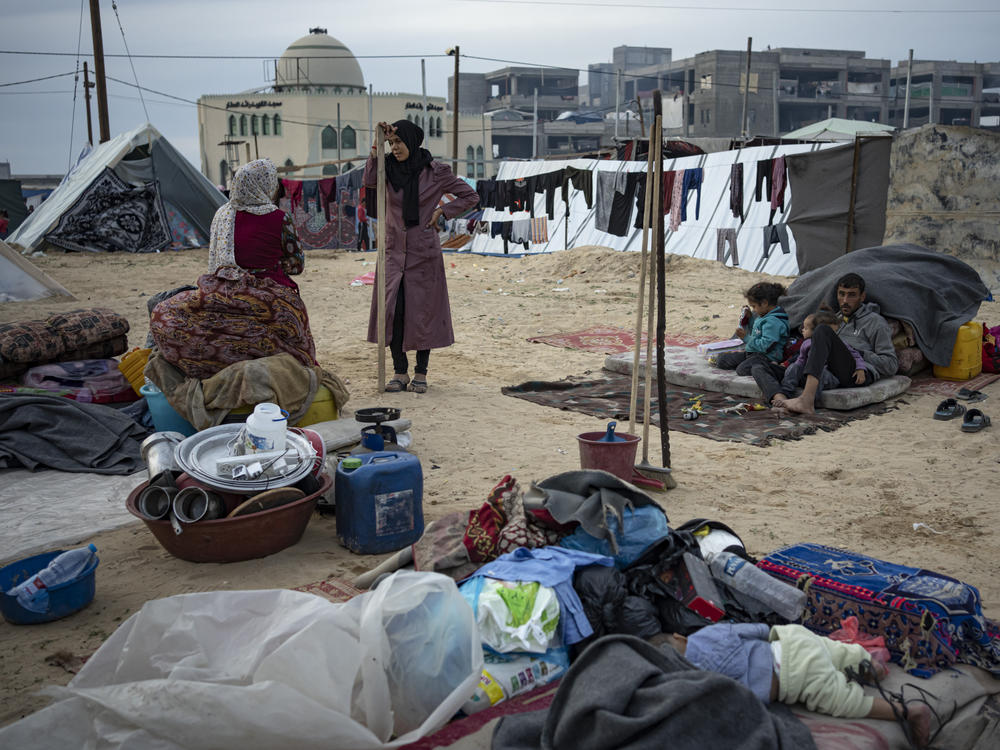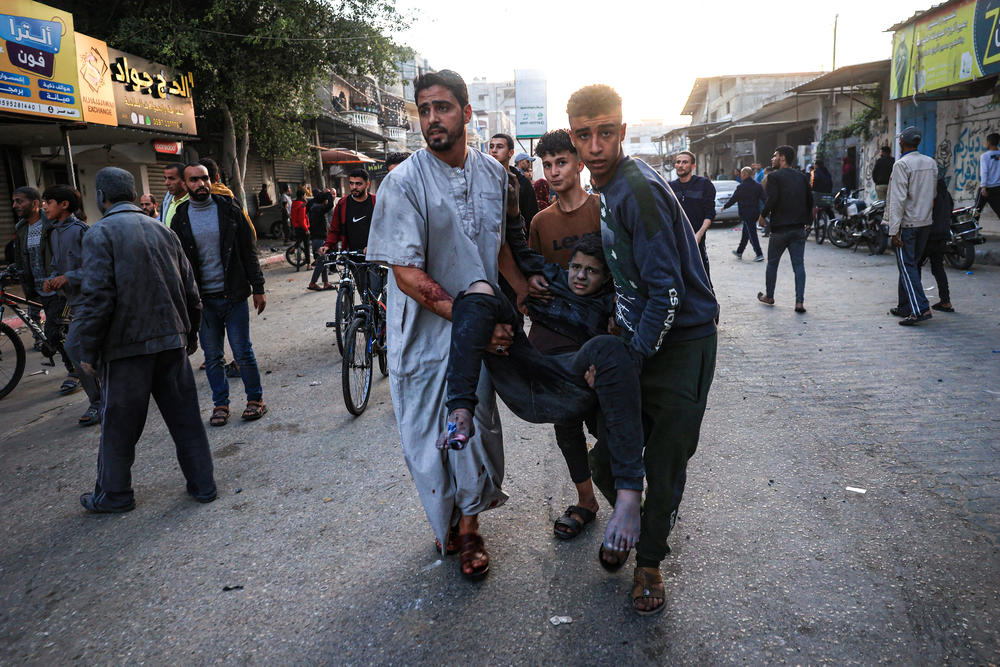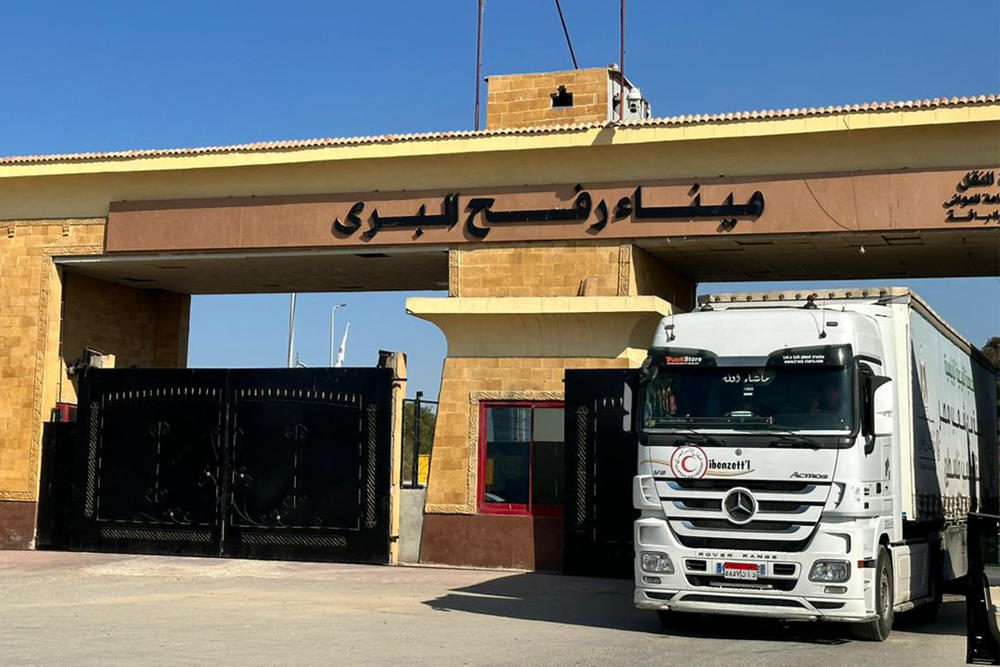Section Branding
Header Content
Delivering aid in a war zone is always difficult. In Gaza, it's proving even harder
Primary Content
TEL AVIV, Israel — International aid groups are periodically called upon to provide food, water, medicine and other vital supplies to people caught in war zones. But getting that critical aid to a population on the run and under fire presents enormous challenges, humanitarian groups say, and the situation in Gaza is proving particularly difficult.
"We are being slammed left, right and center," says Juliette Touma, a spokesperson for UNRWA, the United Nations relief agency that aids Palestinians.
"This is very different than any other conflict or war we've had to manage," Touma says, adding that it is the largest humanitarian response operation in UNRWA's nearly 75-year history.
According to Gaza's Health Ministry, at least 17,000 Palestinians have been killed and more than 46,000 wounded in Israel's air and ground campaign. It came in response to the surprise Oct. 7 attack by Hamas militants on southern Israel, which killed 1,200 people, Israel says.
U.N. agencies and organizations such as the International Committee of the Red Cross, the Palestine Red Crescent Society and Doctors Without Borders say they are struggling to meet the needs of Gaza's 2.3 million people, 85% of whom have been displaced by the fighting.
Paul Spiegel, director of the Center for Humanitarian Health at Johns Hopkins University in Baltimore, is a physician and epidemiologist who spent decades working in such war-torn countries as Afghanistan and Ukraine. He says that in Gaza, "there are many unique aspects to it, which makes it so difficult."
Here's a look at some of those obstacles:
Getting enough aid into Gaza is proving impossible
The war has shut down all but one entry point into Gaza, with a crossing at Rafah, along the border with Egypt, now the single way in for convoys delivering aid. During a weeklong pause in the fighting, about 200 aid trucks per day were crossing at Rafah, far short of what aid experts said was needed. However, since the fighting resumed, the number of vehicles with relief supplies making it through has fallen.
Spiegel, who is currently in Cairo working with international aid groups, says very few vehicles are getting through — "maybe 100 a day, sometimes none."
Since the end of the cease-fire on Dec. 1, "we've seen a significant decrease in the flow of humanitarian assistance coming into Gaza," Touma says.
She says the reduced aid getting to Palestinians in Gaza is because of the heavy fighting, which means distribution is hampered in conjunction with the smaller convoys that are not enough to replenish aid stocks. Since the outbreak of the war, Israel has restricted shipments of fuel that it says could fall into the hands of Hamas. Without fuel, generators needed for electricity can't operate — a fact that has crippled Gaza's health system.
An overwhelming number of displaced people are on the move
Ahmad Mohammad Shannan, from Jabalia in Gaza's north, told NPR that to escape the fighting in the north in the war's early weeks, he went south to Khan Younis, Gaza's second-largest city. When that city became the focus of fighting in recent days, Shannan came to Rafah.
"They brought us here where there is no food or drink," he says. "They distribute food, but it's not enough."
Before the war, UNRWA, which ran dozens of schools in Gaza, had planned for 50 shelters to temporarily house 150,000 people in case of conflict, Touma says.
Now, more than half of Gaza's total population, 1.2 million people, is at 150 shelters run by the agency. And most of the people are crammed into about one-quarter of the territory, less than 40 square miles, Touma says.
"So our teams are stretched to the limit," she says. "Our capacities are stretched. We are overwhelmed. This is seven or eight times more [people] than we have planned for and three times as many facilities."
Nufuz Shaban el Ghoof, in Rafah after arriving from the Khan Younis area, told NPR that he was told to move south because of the intensity of the shelling.
In Khan Younis, he, his children and his grandchildren had been staying in a school. Now he's living in a tent in Rafah.
He says people are becoming desperate enough to resort to theft, and he complains about the crowded circumstances.
"People steal from starvation," Ghoof says.
It's so crowded where he's staying that "you cannot walk from the crowdedness of the tents."
With much of Gaza's population now crammed into the southernmost one-quarter of the territory, there's also a "lack of humanitarian space," says Spiegel. It's a situation made worse by Israel's relentless bombardment, which has laid waste to whole sections of Gaza's urban centers, he says.
As combat operations have increased pressure on civilians, Israel's military has declared "safe zones" where it says people can seek refuge from the fighting. But international aid groups say these zones are inadequate.
Instead, the fighting has caused "a constant displacement [of people] with no safe zones," Spiegel says. "And probably the most unique component is that there is no escape valve."
With fighting to the north, Israel to the east, the Mediterranean Sea to the west and Egypt's closed border with Gaza in the south, people have nowhere to go, Spiegel says.
"You've got this massive fighting and massive bombardment in a small contained area, and there's just no space for people to move and flee and for the humanitarian organizations to respond," he says.
Aid workers on the ground are in constant physical danger
In two incidents last month, Doctors Without Borders came under direct Israeli fire twice within a matter of days, the head of operations for the group, Michel Lacharité, says.
On Nov. 18, personnel displaying the MSF logo — the abbreviation for the group's French name — on vehicles' hoods, backs and doors "came face-to-face with an Israeli tank, and a soldier shot at them," Lacharité says.
Israel's military has not addressed the MSF attacks directly but has said that it "recognizes the importance of the special protections given to medical teams under international humanitarian law and takes action to prevent harm to them."
UNRWA's Touma says there are "a number of our facilities that have been hit, sometimes more than once, directly [and] indirectly."
She says UNRWA facilities have been hit 126 times in total since the war in Gaza began.
NPR's Scott Neuman reported from Tel Aviv, Israel. NPR producer Anas Baba contributed from Rafah, in the Gaza Strip.
Copyright 2023 NPR. To see more, visit https://www.npr.org.



